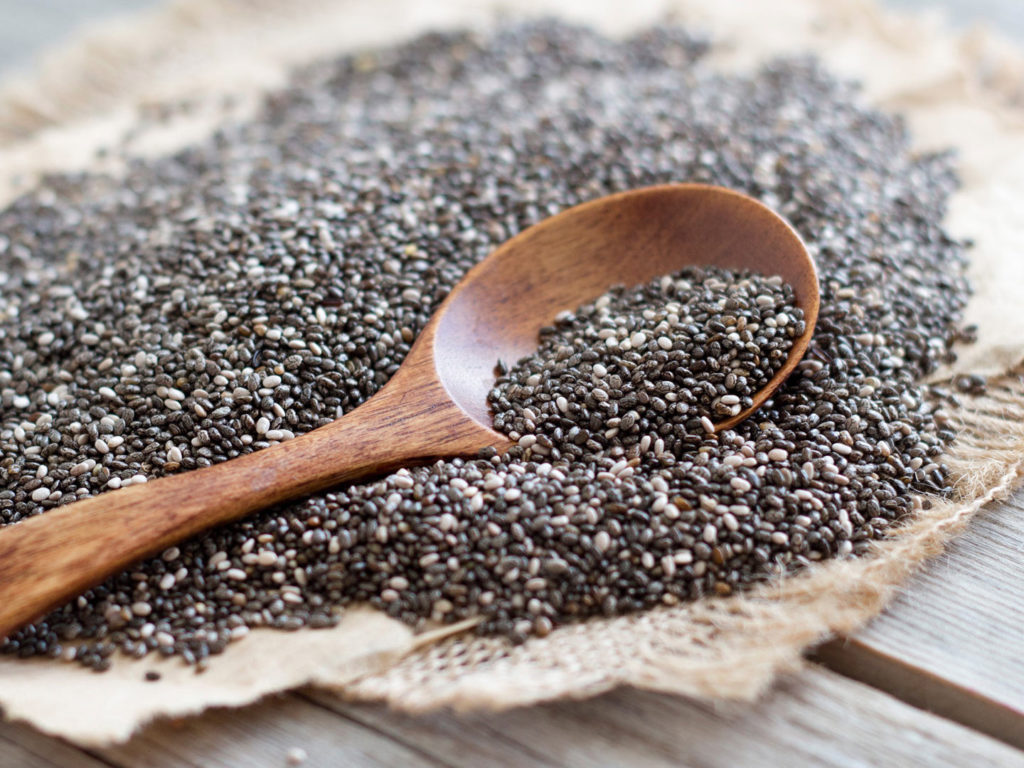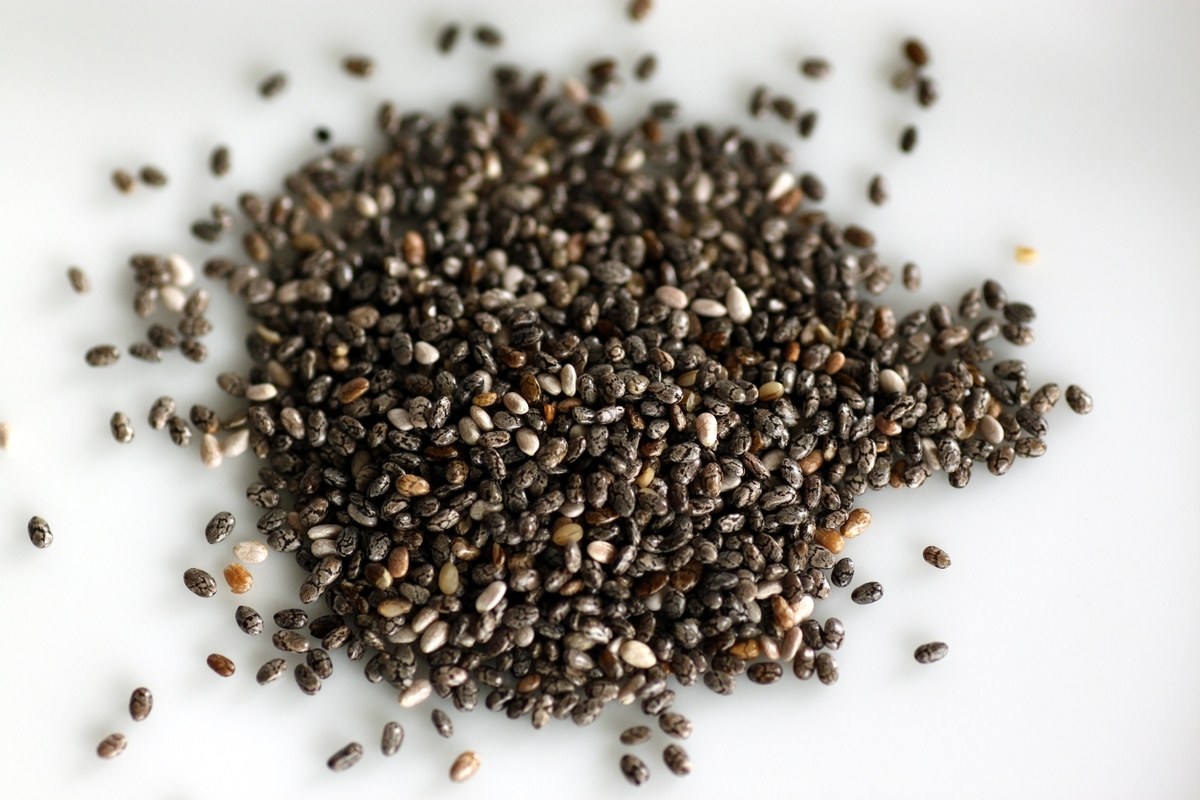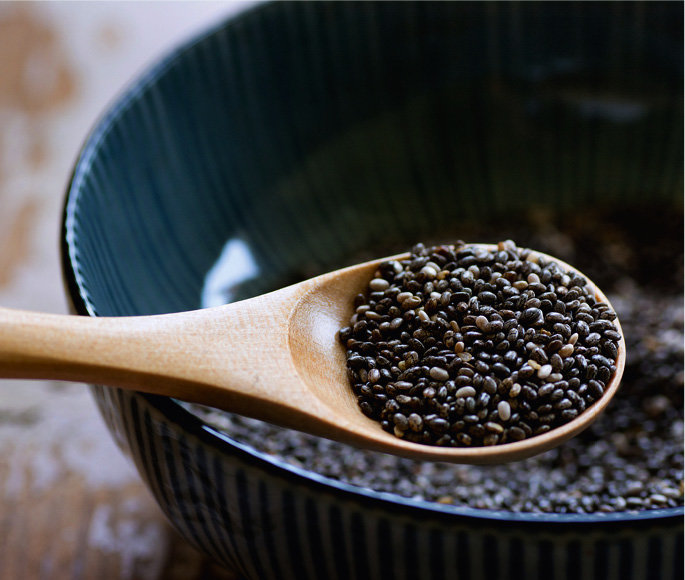
Chia seeds are tiny black and white seeds from the plant Salvia hispanica, which is related to the mint. From beverages to baked goods, these seeds are said to have been used by Mayan and Aztec cultures for “supernatural powers”. In Mayan, “chia” means “strength.” This probably has to do with the large amounts of energy provided by chia seeds. Ancient warriors attributed their stamina to this tiny seed.
Chia was first used by the Aztecs as early as 3500 B.C. and was a cash crop in the centre of Mexico between 1500 and 900 B.C. Pre-Columbian civilisations used chia as a raw material for medicines, nutritional compounds. Chia was used by the Aztecs as food, mixed with other foods, mixed in water and drunk as a beverage, ground into flour, included in medicines, and pressed for oil. Chia flour could be stored for many years and could be easily carried on long trips, serving as a high-energy food. The aztecs also offered chia to their gods during religious ceremonies.
When the Spanish conquerors landed the new land in 1500s, they repressed the natives, and suppressed their existing traditions and trade system. Many crops that had held a major position in pre-Columbian American diets were banned by the Spanish because of their close association with religion. Chia, as the result, was deliberately eliminated. Chia survived only in regional areas of Mexico for the last 500 years. It wasn’t until the mid-20th century that Latin American governments began to re-establish chia seeds as a national agricultural product.
Chia seeds are cultivated on a small scale in their ancestral homeland of central Mexico and Guatemala and commercially throughout Central and South America.
Chia Seed Benefits
Highly Nutritious
Chia is one powerful little seed, as it delivers the maximum amount of nutrients with minimum calories. They have several of the same benefits as the more well-known “super seed” flax, but unlike flax seed, you don’t need to grind them to reap the health benefits.
A 2 tablespoon serving (28g) contains 138 calories and 9 grams of fat, along with a whopping 11g of fibre, 5g of protein and 18% of the daily value for calcium, plus other important minerals. It’s also surprisingly packed with alpha-linolenic acid omega-3s (4,500mg), more than you’ll find in flaxseed. This makes them one of the world's best sources of several important nutrients, calorie for calorie.
Chia boasts an impressive array of flavonoid and polyphenol anti-oxidants including quercetin, kaempferol, chlorogenic acid and caffeic acid. It has three times the amount of anti-oxidants as blueberries for equal volume.
This combination of nutrients is perfect for healthy blood sugar levels and sustained energy. A diet that includes chia seeds is a powerful combatant for diabetes, heart disease and metabolic syndrome.
High in Omega 3
Contributing to its superseed status, chia is one of the most concentrated sources of omega-3 in any food. It also contains high amounts of omega-6. Everyone needs to consume high amounts of these essential fatty acids in their diet, because these EFAs build new cells and regulate various processes of the body, but our bodies cannot make them internally. They also support heart health and beautiful skin, hair and nails.
Like flaxseeds, chia seeds are very high in omega-3 fatty acids. In fact, chia seeds contain more omega-3s than salmon, gram for gram. However, it’s important to keep in mind that the omega-3s in them are mostly ALA (alpha-linolenic acid), which is not as beneficial as you may think. ALA needs to be converted into the active forms eicosapentaenoic acid (EPA) and docosahexaenoic acid (DHA) before your body can use it. Unfortunately, humans are inefficient at converting ALA into these active forms. Therefore, plant omega-3s tend to be vastly inferior to animal sources like fish oil (21). Because they don't supply any DHA, which is the most important omega-3 fat, most experts consider chia seeds a lower-quality omega-3 source. Studies in humans and animals have shown that chia seeds may raise blood levels of ALA up to 138%, and EPA up to 39%.
Promote Energy and Endurance
The Mayans and Aztecs originally used chia seeds for their energy and endurance benefits. They were known as “Indian Running Food” and warriors and athletes often consumed a chia seed gel prior to their events to maintain energy and stamina.
It turns out that these same benefits are just as applicable in modern times! In fact one study, found that a chia gel was as effective as energy drinks for maintaining athletic performance. In the study, participants were split into two groups. One group was given an energy drink, and another an energy drink/chia seed gel. Participants completed various running and endurance activities and their results were compared. The study found no difference in performance between the two groups and concluded that chia seeds were as effective as energy drinks in promoting athletic performance. A recipe for this energy gel is given below.
High in Fibre
Almost all of the carbohydrates in chia seeds are fibre. In 28g of chia seeds, the 12g of carbs that it contains 11g of it is fibre, which your body doesn’t digest which does not raise blood sugar or affect insulin levels like other forms of carbohydrates. A high fibre intake has been linked with improved gut health and a lower risk of numerous diseases.
Chia seeds also have a unique ability to “gel” due to the soluble fibre content. The outer shell is hydrophilic and so has the ability to absorb over 10 times their weight in liquid. This makes them filling and satisfying. Researchers think that this gel action also occurs in the stomach, creating a barrier between carbohydrates and enzymes in the stomach which slows the conversion of carbohydrates into sugar. This may account for some of the reported endurance benefits of chia seeds.
This super absorbent nature also helps to hydrate the colon and move toxins out of the gut. The blend of insoluble and soluble fibre helps to sweep and sponge microorganisms and environmental toxins out of the colon and into the faeces. Thus, the fibre works as a prebiotic in the digestive system, so while it isn’t digested and used directly, it feeds the beneficial bacteria in the gut and may help improve gut health. It has also been linked to decreased risk of diabetes, increased stool bulk and reduced constipation.
Adding just 2 tbsp of chia seeds to your diet can reduce caloric intake and double the amount of fibre you would consume. As this high fibre seed promotes a feeling of fullness, it could prevent overeating which leads to weight gain. However, more evidence is needed to support this concept.
Bone Health
Chia seeds are high in several nutrients that are important for bone health. This includes calcium, phosphorus, magnesium and protein.
In 28g (=2 tablespoons): % of the RDI (Recommended Daily Intake)
Calcium: 18% (three times more calcium than skimmed milk)
Manganese: 30%
Magnesium: 30%
Phosphorus: 27%
Gram for gram, this is higher than most dairy products and so would make an excellent source of calcium for people who don't eat dairy.

Lowers High Blood Sugar
Chia seeds may lower the rise in blood sugar after a high-carb meal, possibly benefiting people with type 2 diabetes.
Animal studies have found that chia seeds may improve insulin sensitivity and blood sugar control, stabilising blood sugar levels after meals. A few human studies support this by showing that eating bread that contains chia seeds lowers the post-meal rise in blood sugar compared to bread that doesn’t include any chia.
Boosts Mental Function
Chia is loaded with omega 3 fatty acids and neuro-protective anti-oxidants such as quercetin, caffeic and chlorogenic acid. These essential fats and anti-oxidants produce cell membranes that are more flexible and efficient. Healthier cell membranes results in more efficient nutrient delivery systems and faster nerve transmission processes. This improves brain function including memory and concentration.
Recipes for Health
Chia seeds are incredibly easy to incorporate into your diet. The seeds themselves taste rather bland, so you can add them to pretty much anything. They also don't need to be ground like flax seeds, which makes them much easier to prepare. They can be eaten raw, soaked in juice, added to porridge, pudding, smoothies or added to baked goods. You can also sprinkle them on top of cereal, yogurt, vegetables or rice dishes. Because of their ability to absorb both water and fat, they can be used to thicken sauces and as egg substitutes in recipes. Mixed with water, they can replace egg in vegan cooking or for those with egg allergies. Simply mix one part chia seeds to six parts water. About one tablespoon of this gel equals one large egg. When combined with liquid, chia seeds swell and form a gel. Chia’s ability to gel also makes the seeds a fine substitute for pectin in jam (Recipe below).
Chia seeds are an integral ingredient in the Mexican and Central American favourite drink: Chia Fresca (Recipe below), in which the seeds are mixed into lime or lemon juice with added sweetener.
Energy Gel
Great energy gel for endurance activities:
Add a couple tablespoons of chia seeds to a cup of coconut water.
Let sit for about ten minutes and you’ll have an incredible energy gel!
Blueberry Chia Jam
Ingredients
· 1 1⁄4 cup frozen wild blueberries
· 1 1⁄2 tablespoons pure maple syrup or honey
· 1 tablespoon chia seeds
· 1⁄2 teaspoon vanilla extract (fresh, minced ginger or lemon juice also work well as flavouring agents in this jam).
Instructions
1. In small saucepan over medium heat, add blueberries and maple syrup/honey. Stir and cook the blueberry mixture for 10 minutes. Use a potato masher to mash blueberries.
2. Add 1 tablespoon of chia seeds and continue to cook and stir for about 2 to 3 minutes or until blueberry mixture resembles a jam consistency.
3. Remove from heat and blend in vanilla extract.
4. Refrigerate and use within a week.

Lemon Chia Fresca
Ingredients
· Tall glass of cold water
· 2 Tablespoons lemon juice
· 2-3 teaspoon chia seeds
· 5-6 drops liquid stevia (or 2 teaspoons maple syrup/honey)
· pinch of cayenne pepper
Instructions
1. Combine all ingredients in a glass and let sit for about 15 minutes in the fridge so the chia seeds have a chance to absorb some of the liquid and “gel” up.
2. Enjoy immediately or save for later.
3. Can be made ahead of time as the mixture should last at least 2-3 days in the fridge.
Precautions
Chia seeds generally do not cause any adverse effects. However, to avoid possible digestive side effects, drinking plenty of water with chia seeds is generally advised, especially if they have not been soaked before eating.
Like all grains and seeds, chia seeds contain compounds called phytic acid. Phytic acid is a plant compound that binds with minerals, such as iron and zinc, and inhibits their uptake from foods. This is the reason that many ancient cultures soaked and fermented grains and seeds prior to eating them. Chia seeds are naturally gluten free and are a good source of many nutrients. Though they do contain phytic acid, they do not contain as high of levels as many other nuts and seeds. There is also some evidence that soaking and rinsing the seeds may help reduce the levels of phytic acid, thus releasing the nutrients from the seed.
Large doses of omega-3 fats, such as those from fish oils, may have blood thinning effects. If you are taking blood-thinning medications, then consult with your doctor before incorporating large amounts of chia seeds into the diet. The omega-3 fatty acids may affect the activity of the medication.
Chia seeds can absorb up to 27 times their weight in water so it is important to mix chia seeds into another food or liquid before consuming, especially for people with a history of swallowing problems. Small children should not be given chia seeds.
To Sum Up…
Chia seeds are very rich in fibre, antioxidants, minerals, and omega-3 fatty acids. A few spoonfuls daily might be powerful enough to improve risk factors for heart disease and diabetes, lead to better digestive and bone health, plus boost endurance and mental function. Chia is such a versatile seed and so very easy to incorporate into a healthy diet. Adding chia seeds to any recipe will dramatically boost their nutritional value. They are truly worthy of their reputation as a superfood.
Source
http://www.ancientgrains.com/chia-seed-history-and-origin/
https://foodandnutrition.org/january-february-2014/chia-seeds-tiny-seeds-rich-history/
https://www.doctoroz.com/blog/lindsey-duncan-nd-cn/chia-ancient-super-secret
https://beyondtheequator.com/blog/2017/01/31/a-history-of-chia-seeds
https://www.eatingbirdfood.com/lemon-chia-fresca/
https://www.healthline.com/nutrition/11-proven-health-benefits-of-chia-seeds#section12
https://www.medicalnewstoday.com/articles/291334.php
https://draxe.com/chia-seeds-benefits-side-effects/
https://www.healthline.com/nutrition/foods/chia-seeds#section6
https://wellnessmama.com/4981/chia-seeds-benefits/
https://drjockers.com/top-3-health-benefits-chia-seeds/
